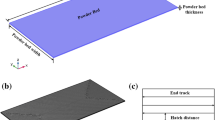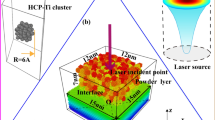Abstract
In the selective laser melting manufacturing, an accurate estimation of residual stresses and distortion is necessary to achieve high-quality specimens. During the manufacturing, the scanned layers are subjected to rapid thermal cycles. Steep temperature gradients generate residual stresses. Residual stresses can be detrimental to the proper functioning and the structural integrity of built parts. Therefore, it becomes particularly important to build a method to control the quality of the model. In order to realize the quality control of the SLM modeling, in this study, a three-dimensional model was developed for studying thermal behavior and residual stress during selective laser melting (SLM) of AlSi10Mg. Through the simulation, a prediction method for residual stress and deformation is found. To explore the relationship of the thermal effect between adjacent scanning trajectories, the calculated residual stress distributions are compared with independent experimental results. The effects of process parameters such as the laser power, scan speed, and scan strategy on the residual stress were also investigated. The results showed that the stress of the specimen gradually increased during the SLM process, caused by a heat accumulation effect.
Similar content being viewed by others
References
Thijs L, Kempen K, Kruth JP, Humbeeck JV (2013) Fine-structured aluminium products with controllable texture by selective laser melting of pre-alloyed AlSi10Mg powder. Acta Mater 61(5):1809–1819
Brandl E, Heckenberger U, Holzinger V, Buchbinder D (2012) Additive manufactured AlSi10Mg samples using selective laser melting (SLM): microstructure, high cycle fatigue, and fracture behavior. Mater Des 34:159–169
Kempen K, Thijs L, Humbeeck JV, Kruth JP (2012) Mechanical properties of AlSi10Mg produced by selective laser melting. Phys Procedia 39:439–446
Kruth JP, Levy G, Klocke F, Childs THC (2007) Consolidation phenomena in laser and powder-bed based layered manufacturing. CIRP Ann Manuf Technol 56(2):730–759
Gu DD, Meiners W, Wissenbach K, Poprawe R (2013) Laser additive manufacturing of metallic components: materials, processes and mechanisms. Int Mater Rev 57(3):133–164
Zhang B, Liao H, Coddet C (2012) Effects of processing parameters on properties of selective laser melting Mg–9%Al powder mixture. Mater Des 34(34):753–758
Zhang B, Dembinski L, Coddet C (2013) The study of the laser parameters and environment variables effect on mechanical properties of high compact parts elaborated by selective laser melting 316L powder. Mater Sci Eng A 584(6):21–31
Aggarangsi P, Beuth JL 2006 Localized preheating approaches for reducing residual stress in additive manufacturing. Proc Sff Symp
Salmi A, Atzeni E, Iuliano L, Galati M (2017) Experimental analysis of residual stresses on AlSi10Mg parts produced by means of selective laser melting (SLM). Proc CIRP 62:458–463
Liu Y, Yang Y, Wang D (2016) A study on the residual stress during selective laser melting (SLM) of metallic powder. Int J Adv Manuf Technol 87(1–4):647–656
Childs THC, Hauser C, Badrossamay M (2005) Selective laser sintering (melting) of stainless and tool steel powders: experiments and modelling. Proc Inst Mech Eng B J Eng Manuf 219(4):339–357
Read N, Wang W, Essa K, Attallah MM (2015) Selective laser melting of AlSi10Mg alloy: process optimisation and mechanical properties development. Mater Des 65:417–424
Kempen K, Thijs L, Humbeeck JV, Kruth JP (2015) Processing AlSi10Mg by selective laser melting: parameter optimisation and material characterisation. Mater Sci Technol 31(8):917–923
Mazur M, Leary M, Sun S, Vcelka M, Shidid D, Brandt M (2015) Deformation and failure behaviour of Ti-6Al-4V lattice structures manufactured by selective laser melting (SLM). Int J Adv Manuf Technol 84:1391–1411
Anwar AB, Pham Q-C (2017) Selective laser melting of AlSi10Mg: effects of scan direction, part placement and inert gas flow velocity on tensile strength. J Mater Process Technol 240:388–396
Liu C, Cai Z, Dai Y, Huang N, Xu F, Lao C (2018) Experimental comparison of the flow rate and cooling performance of internal cooling channels fabricated via selective laser melting and conventional drilling process. Int J Adv Manuf Technol 96:2757–2767
Bai X, Zhang H, Wang G (2015) Modeling of the moving induction heating used as secondary heat source in weld-based additive manufacturing. Int J Adv Manuf Technol 77(1):717–727
Garg A, Tai K, Savalani MM (2014) Formulation of bead width model of an SLM prototype using modified multi-gene genetic programming approach. Int J Adv Manuf Technol 73(1–4):375–388
AlMangour B, Grzesiak D, Yang J-M (2017) Selective laser melting of TiB2/316L stainless steel composites: the roles of powder preparation and hot isostatic pressing post-treatment. Powder Technol 309:37–48
Mercelis P, Kruth JP (2006) Residual stresses in selective laser sintering and selective laser melting. Rapid Prototyp J 12(5):254–265
Mukherjee T, Zhang W, DebRoy T (2017) An improved prediction of residual stresses and distortion in additive manufacturing. Comput Mater Sci 126:360–372
Bhadeshia HKDH (1986) An analysis of cooling curves from the fusion zone of steel weld deposits. Scand J Metall 15:97–103
Manvatkar V, De A, Debroy T (2014) Heat transfer and material flow during laser assisted multi-layer additive manufacturing. J Appl Phys 116(12):133
Gusarov AV, Pavlov M, Smurov I (2011) Residual stresses at laser surface remelting and additive manufacturing. Phys Procedia 12(1):248–254
Papadakis L, Chantzis D, Salonitis K (2017) On the energy efficiency of pre-heating methods in SLM/SLS processes. Int J Adv Manuf Technol 95(1–4):1325–1338
Yuan P, Gu D, Dai D (2015) Particulate migration behavior and its mechanism during selective laser melting of TiC reinforced Al matrix nanocomposites. Mater Des 82:46–55
Zaeh MF, Branner G (2010) Investigations on residual stresses and deformations in selective laser melting. Prod Eng 4(1):35–45
Dong L, Makradi A, Ahzi S, Remond Y (2009) Three-dimensional transient finite element analysis of the selective laser sintering process. J Mater Process Technol 209(2):700–706
Dong L, Makradi A, Ahzi S, Remond Y (2007) Finite element analysis of temperature and density distributions in selective laser sintering process. Mater Sci Forum 553(3):75–80
Papadakis L, Loizou A, Risse J, Bremen S (2013) A thermo-mechanical modeling reduction approach for calculating shape distortion in SLM manufacturing for aero engine components. Brain Res 53(2):387–398
Hodge NE, Ferencz RM, Solberg JM (2014) Implementation of a thermomechanical model for the simulation of selective laser melting. Comput Mech 54(1):33–51
Carslow HS, Jaeger JC, Morral JE (1992) Conduction of heat in solids, second edition. J Eng Mater Technol 108(4):378
Hussein A, Hao L, Yan C, Everson R (2013) Finite element simulation of the temperature and stress fields in single layers built without-support in selective laser melting. Mater Des 52:638–647
Yin J, Zhu H, Ke L, Lei W, Dai C, Zuo D (2012) Simulation of temperature distribution in single metallic powder layer for laser micro-sintering. Comput Mater Sci 53(1):333–339
Dai K, Shaw L (2005) Finite element analysis of the effect of volume shrinkage during laser densification. Acta Mater 53(18):4743–4754
Touloukian YS, Ho CY (1970) Thermal conductivity. Metallic elements. IFI/Plenum, New York
Touloukian YS, Buyco EH (1970) Specific heat : metallic elements and alloys. IFI/Plenum, New York
Funding
The authors would like to acknowledge the support of Innovation Funding of Shanghai Aerospace Science and Technology. (no. SAST2016054) and Shanghai Science and Technology Talents Program Fund (no. 15QB1401400), and Industrial Strong Base Engineering of Ministry of Industry and Information Technology (Metal Powder Material Enhancement Process Implementation Scheme TC160A310 / subcontract no. 19) rapid fabrication of complex ultra-high temperature components (no. 17-163-13-ZT-010-036-01).
Author information
Authors and Affiliations
Corresponding authors
Rights and permissions
About this article
Cite this article
Wang, L., Jiang, X., Zhu, Y. et al. An approach to predict the residual stress and distortion during the selective laser melting of AlSi10Mg parts. Int J Adv Manuf Technol 97, 3535–3546 (2018). https://doi.org/10.1007/s00170-018-2207-3
Received:
Accepted:
Published:
Issue Date:
DOI: https://doi.org/10.1007/s00170-018-2207-3




